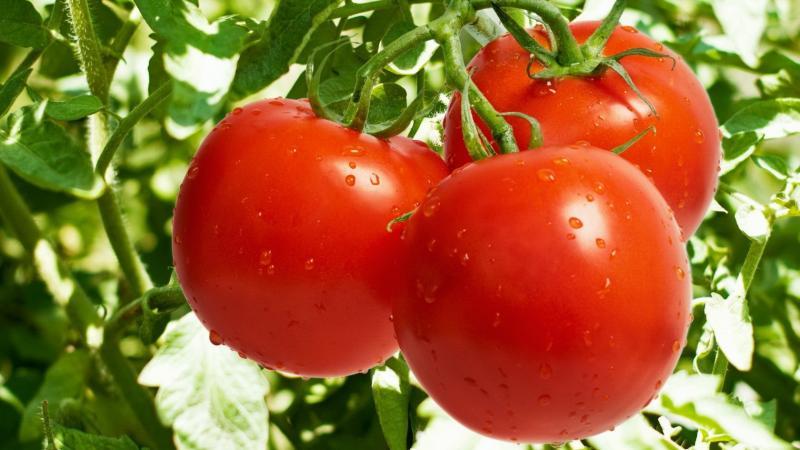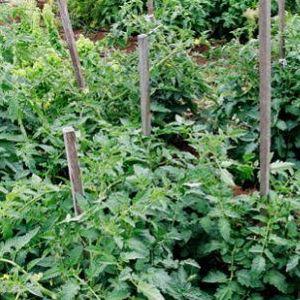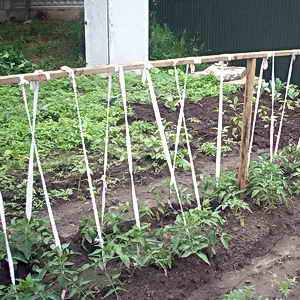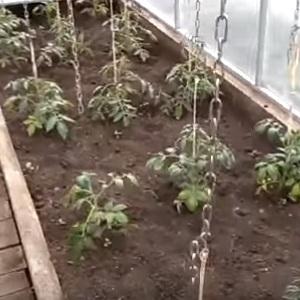Ways to tie tomatoes in the open field: how to do it right and is it necessary at all
After planting in the ground, tomato bushes begin to grow actively. When growing green mass, many varieties need additional care - fastening the plant to the support. Consider how to properly tie tomatoes in the open soil.
The content of the article
Why tie up tomatoes
Not all tomato bushes require a garter. Stocky low-growing plants with medium-sized fruits do not need this. They will grow beautifully and give a harvest without it. But tall plants, bushes with thin or weakened stems, large fruits require additional attention and care.
Here are some reasons that support the benefits of tying tomatoes:
- If you neglect the garter, the plant may not withstand a sharp increase in the load on the stem during the period of active growth of green mass or fruits. The stem will break.
- It is easier to look after the bushes fixed to the supports (feed, water, pinch).
- Air circulates freely between the tied plants and the sun's rays penetrate, which are necessary for the full development of tomatoes.
- Bushes that do not come into contact with leaves, stems and fruits with the soil are less sick, they are less likely to be affected by pests.
- The fruits will grow clean and will not rot from contact with moist soil.
Let's reveal a few secrets of how best to tie up tall tomatoes.
Do I need to tie up tomato brushes
This procedure is optional. If the bush itself is anchored to a support, this is usually enough for the plant to support its weight, even if the bushes are tall. But if you grow large-fruited varieties of tomatoes, it is better to take care of the garter of fruit brushes. Tying up large tomatoes means helping the plant retain harvest.
Experienced gardeners, in order to quickly tie up bunches, are advised to make gauze bags. Attach brushes with large tomatoes to the stem or to external supports.

How to tie
To attach tomatoes to supports, it is better to use soft materials that will not injure the plant stem:
- stripes of fabric;
- twine;
- rope;
- bulky knitting yarn;
- sewing tape;
- stripes of nylon stockings or tights.
Attention! It is undesirable to use thin threads, fishing line or wire when tying plants. These materials will cut into the stems and harm the tomatoes.
Why tie up
The choice of a garter method depends on the materials at hand, as well as on financial capabilities. There are many ways to tie tomatoes, we will consider them in order.
On pegs
 This is the most common way to tie tomatoes outdoors.
This is the most common way to tie tomatoes outdoors.
Pegs fit:
- wooden;
- metal;
- plastic.
The pegs are stuck into the soil at the base of the stem, and then the plant itself is tied to a support. The number of supports is one or two per bush.
The optimum peg length should be greater than the maximum height of an adult tomato bush. Garter bands are wrapped around the tomato stem, starting from the ground and working up to the top of the plant.
Important! Before tying tomatoes, experienced gardeners recommend cutting off the lower leaves of the plants so that there is no additional contact between the bush and the ground.
On trellises
 Gardeners build trellises by digging several supports in a row, usually high slats or stakes. Horizontal supports are laid between the vertical supports. This is how the trellises look in the photo:
Gardeners build trellises by digging several supports in a row, usually high slats or stakes. Horizontal supports are laid between the vertical supports. This is how the trellises look in the photo:
Tomato bushes are attached to the supports with garter material.
Some tomato growers believe that it is better to wrap the garter material around the plant in a clockwise direction.
This is due to the fact that the sun moves clockwise, and the tomatoes turn after it.
On a wire frame
This method of tying tomatoes is suitable for those who have few tomato bushes on the site (due to the high cost of materials). It allows you to tie tomatoes in the garden without stakes.
Such a frame is bought ready-made or weaved on its own, if there is a wire. It looks like a cage with tomato bushes (usually one to three) planted inside.
Important! When tying tomatoes, it is best not to tighten the garter strips tight. It is also recommended to attach the bush in several places. This will eliminate the risk of damage to the plant.
To the mesh fence
Another way to tie tomatoes without sticks. It consists in tying the bushes to a fence made of metal or plastic mesh. The net for the supports is pulled over the stakes in the aisles of the tomatoes.
Plants are attached to the mesh fence with garter material.
Important! Professional tomato growers do not recommend using the same garter material for several years in a row, since it gradually becomes a source of tomato diseases.
On hooks and chains
 Another way to tie. But more often it is used in greenhouses made of polycarbonate.
Another way to tie. But more often it is used in greenhouses made of polycarbonate.
It consists in the fact that a chain is lowered to the vertical support above the tomato bushes. The tomato bush is attached to the chain links with a garter, at the end of which a hook is installed.
As the plant grows, the hook is outweighed to higher chain rings.
The method can be adapted for use in the open field if the chain is vertically descended from the supports installed between the growing tomato bushes.
Let's sum up
Do I need to tie up tomatoes outdoors? It all depends on the variety and height of the bush. Tying tomatoes is one of the important steps in the care of tall plants for a good harvest.
There are many ways of attaching stems to supports in open ground, and each tomato grower chooses the most convenient for himself. Most often, when tying up bushes, they manage with improvised means - stakes, wooden slats and sticks, strips of old fabric or unnecessary nylon tights. Tomatoes on the garden bed they tie up without stakes, using a net or wire frame. When attaching bushes to supports, it is important not to use materials that can damage the plants (thin threads, fishing line or wire). The considered methods of tying are suitable not only for growing tomatoes in the open field, but also for a greenhouse.